Abstract
While the internal load factors of whole-body vibration training have been widely investigated, the study of external load magnitude has been overlooked. Thus, the aim of the present study was to evaluate differences in whole-body vibration stimulus magnitude between static/dynamic whole-body vibration training at various vibration conditions. Four Pro 5 Plate vibration platforms were exposed to twelve different vibration conditions and a triaxial USB Impact X250-2 accelerometer was used to measure platform acceleration during each condition. Paired samples t-test was calculated to evaluate differences among amplitude, frequency, time of acceleration and time of deceleration of each platform at each vibration condition and during static (squat of 90° knee flexion) or dynamic exercise (from stand to 90° knee flexion squat). Also, the intra-class correlation coefficients were examined in order to assess the inter-instrument reliability. Peak-to-peak amplitude, frequency, time of acceleration and deceleration of the vibration platform were not modified by the type of exercise performed. Moreover, the four platforms tested showed high repeatability values during the execution of free vibration, static or dynamic squat in all vibration conditions. This study confirms that the vibration delivered by the Pro 5 Plate vibration platform is not modified during the realization of static or dynamic exercises.
1. Introduction
Training effects of whole-body vibration (WBV) have been widely investigated in several target groups. Also, meta-analysis showed WBV benefits for performance and health in muscle power [1], squat jump (SJ) height [2], counter movement jump (CMJ) height [2, 3], muscle strength [4-6], knee extension muscle strength [3], bone mineral density (BMD) [7], and balance ability and mobility [8, 9]. However, these effects over the organism adaptation could depend on the WBV load [1, 2, 4].
The load of WBV is obtained by the combination of four main variables as frequency (Hz), amplitude (mm), acceleration (m·seg-2 or g) and duration (min or s) [10, 11]. Moreover, several studies have used surface-electromyography-root-mean-square (sEMGRMS) to identify the conditions that maximize acute neuromuscular responses [12-17], and they propose the idea of individualize the acceleration load by sEMGRMS, due to the personal character of the vibration responses [12-14]. The vibration magnitude (acceleration) that is transferred to the body depends on the dampening of the tissues and the structural stiffness [11, 18], the subject position on the WBV platform [14, 15], and the type of exercise performed (static vs. dynamic) [19]. However, all recently cited studies are focused on the internal load, and few of them are focused on the external load [20], although it is not always the one intended [21, 22].
So, the aim of the present study was to evaluate differences in WBV stimulus magnitude (e.g. acceleration, frequency and amplitude) between static/dynamic WBV training at various vibration conditions.
2. Equipment and methods
Four Pro 5 Plate vibration platforms (Power Plate International Ltd., London, UK), all used for approximately 6 months, were exposed to different vibration conditions (Table 1). Test conditions were assigned in a random order. Each condition lasted 20s, with 60s of rest between each and a subject on the vibration platform (Women, age: 29 years, weight: 60 kg, height: 165 cm). The protocol was conducted according to ethical standards derived from the Declaration of Helsinki for research in Human and was approved by the University’s Human Ethics Committee (University of Zaragoza). Prior to conducting the study a written informed consent was obtained from the subject.
Table 1Vibration condition test
Condition | Frequency (Hz) | Amplitude (mm) | Exercise |
1 | 30 | Low | Free vibration |
2 | 30 | Low | Static |
3 | 30 | Low | Dynamic |
4 | 30 | High | Free vibration |
5 | 30 | High | Static |
6 | 30 | High | Dynamic |
7 | 50 | Low | Free vibration |
8 | 50 | Low | Static |
9 | 50 | Low | Dynamic |
10 | 50 | High | Free vibration |
11 | 50 | High | Static |
12 | 50 | High | Dynamic |
The vibration condition were performed always with the subject on the center of the vibration platform standing with their feet, separated to shoulder-width, except in free vibration in which the platform worked without subject’s weight. During static position the subject was in squat of 90° knee flexion whereas dynamic position was from stand to 90° knee flexion squat.
2.1. Platform acceleration (Pacc)
A triaxial USB Impact X250-2 accelerometer (Concepts of Gulf Coast Data, LLC. Waveland, MS) was used to measure Pacc during each vibration condition. The accelerometer was placed exactly in the center of the vibration platform.
The accelerometer was securely fixed to vibration platform, set on high gain (±28 g), resolution of 16 bits and sample rate of 512 Hz and automatically initialized. Accelerometer data were analyzed using XLR8R software (version 2.1. Gulf Coast Data Concepts, LLC. Waveland, MS).
During vibration, Pacc was computed by means of the acceleration of the platform [23] and the vertical component of acceleration of the vibration platform was measured by an accelerometer.
The accelerations in the , and directions were recorded by an accelerometer according to ISO2954 with a sampling frequency 512 Hz, and denoted , , and , respectively. The beginning of each condition was automatically determined using a signal-dependent threshold based on the mean value of in the first 2 minutes of the recording. The signal excerpt corresponding to the th-condition was denoted . Then, the discrete short time Fourier transform (STFT) was applied to each in order to obtain a time-frequency (TF) representation, which allows the study of accelerometer data both in time and frequency domain simultaneously:
where and are the discrete time and frequency indexes, respectively, and is a short time analysis window of length normalized to be of unit energy. Instantaneous frequency and envelope of are estimated from as follows:
represents the dominant frequency at each time instant, while is related to the amplitude of accelerometer data at each time instant.
In this work the short time analysis window was a normalized Hamming window of 0.2 second-length, and 1024.
For each the acceleration and deceleration times, and , respectively, were computed as the time which takes to pass from the 5 % to the 95 % of its maximum excursion and vice versa. Then, mean, standard deviation, median and median absolute deviation of and were computed in the time interval during which is above the 95 % of its maximum excursion, where acceleration is supposed to have stabilized.
Signals and denote signal excerpts of and , respectively, during the th-condition, whose temporal interval was determined from . Following the same procedure as previously described, the instantaneous frequency and envelope of and were computed and denoted , , and , respectively. Mean, standard deviation, median and median absolute deviation of , , and were computed in the time interval during which is above the 95 % of its maximum excursion. The amplitude of and during conditions is much lower than the amplitude of . For that reason, the temporal interval of each condition, the time interval when acceleration is supposed to have stabilized, acceleration and deceleration times are estimated only from .
During dynamic conditions, exhibited an amplitude modulation with the period of the exercise repetition. In order to characterize this modulation, the discrete Fourier transform (DFT) was applied to in the time interval during which is above the 95 % of its maximum excursion, denoted , i.e:
where is the length of . The frequency and amplitude of the modulation observed in are estimated as:
Now and amplitude refer to frequency and amplitude not of acceleration data but of the amplitude or envelope of accelerometer data in direction during the dynamic exercise.
2.2. Statistical analysis
Data were analyzed using IBM SPSS Statistic 20 software for MAC (Chicago, IL). All data were first examined statistically for normality of distribution. Values are presented as means ± standard deviation (SD) and significance level was set at 0.001.
Paired samples t-test was used to evaluate differences among peak-to-peak amplitude, frequency, time of acceleration and time of deceleration of each platform at each vibration conditions and during static or dynamic exercise.
To assess the inter-instrument reliability, we used intra-class correlation coefficients (ICC) with a two-way random model for absolute agreement, in order to determine the relationship between vibration platforms for each vibration load. An ICC close to 1 represents good repeatability.
3. Results
No significantly differences (0.001) between peak-to-peak amplitude, frequency, time of acceleration and deceleration during free vibration, static and dynamic squat were found by Paired samples -test and are showed in Figs. 1-2.
ICC between platforms at dynamic squat, static squat and free vibration are showed in Table 2.
The results of this study show that mechanical stimulation of the Pro 5 Plate is not modified by the type of exercise performed (dynamic or static). Also, the four platforms tested showed high repeatability values during the execution of free vibration, static or dynamic squat in all vibration conditions.
Recent studies have analyzed if the stimulus provided by the WBV platforms during exercises correspond to that pretends to be. For example Alizadeh-Meghazi et al. found that in 7 vibration platforms (Juventut, Power Plate, VForce, VivePlate, Wave Airflex, Wave ProElite and a custom Wave device) the vibration amplitude and peak acceleration varied according to the weight placed over the platform at 30, 40 and 50 Hz frequencies [21]. However, we did not find significant differences in the t-test (0.001) during static or dynamic exercises as well as on free vibration. These variations may be due to the difference as a resonator reported between static loads and a human body [10], since other human studies suggest that load the device does not affect or slightly affects the applied frequency or mode of vibration [22, 24]. Nevertheless, similarly to the mentioned authors we have observed a tendency in the results since as the frequency increases the vibration amplitude decreases (Fig. 1) [21].
Fig. 1Acceleration, amplitude and frequency during dynamic and static squat.

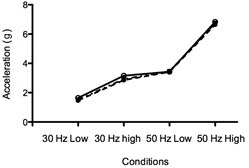
a) Acceleration
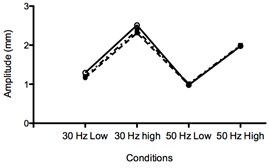
b) Amplitude
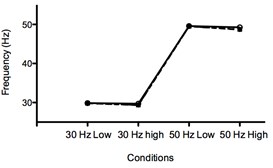
c) Frequency
Fig. 2Acceleration and deceleration time during dynamic and static squat

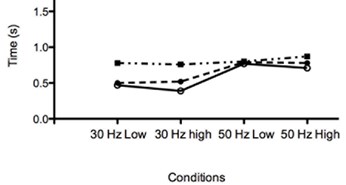
a) Acceleration time
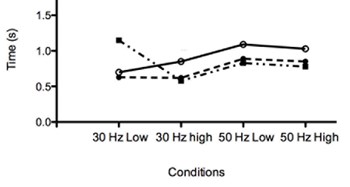
b) Deceleration time
Table 2ICC Results
Frequency (Hz) | Amplitude (mm) | ICC at dynamic/static squat and free vibration | |||
Amplitude | Frequency | Acceleration time | Deceleration time | ||
30 | Low | 0.923 | 0.801 | 0.873 | 0.902 |
30 | High | 0.911 | 0.736 | 0.701 | 0.933 |
50 | Low | 0.982 | 0.799 | 0.700 | 0.905 |
50 | High | 0.933 | 0.906 | 0.803 | 0.987 |
For all the conditions the repeatability was high (> 0.7) for frequency and acceleration time or very high (> 0.9) for peak-to-peak amplitude and deceleration time (Table 2). Also, no significant differences were found in the peak-to-peak amplitude during free vibration, static or dynamic squat. Amplitude is one of the four basic components of the external load and it has been shown its direct relationship with acute physiological responses, such as oxygen consumption [25] or muscle activation [13, 26], besides Hazell et al. suggested that this relationship is independent of whether the exercise performed is static or dynamic [27].
Regarding the frequency, no significant differences were shown according to the type of exercise that was being executed on the platform. Frequency is one of the components of the external load that have been studied in greater detail, it seems that low vibration (25-30 Hz) could be useful to get a greater response of the calf muscles [12, 15]. Moreover, higher frequency vibrations than 30-55 Hz appear to be more effective in stimulating the thigh muscles, since they get overcome the damping effect exerted by the calf muscles and the knee [12, 15].
Finally, as expected by the results of the peak-to-peak amplitude and frequency, the acceleration was not modified by the exercise (dynamic or static) performed (0.001).
The execution of dynamic squats with WBV has proven been as enough stimulus to increase the acute strength [19]. Also, the muscle activity during WBV exercise seems to be higher during dynamic exercise than in static [27]. Meanwhile the 90° static squat has shown regarding other commonly used isometric body positions, greater activation of the knee extensors measured by sEMGRMS [15], although activation of plantar flexors is larger at 90° with raised heels or at wider angles of knee [14, 15].
The results of our study cannot be generalized as we only used relatively new vibration platform of the same commercial brand and no different weights were applied over the platform. It has been reported that prolonged use will result in divergences between the preset and real applied frequencies as well as in the mode of vibration, [22, 28] and it has been also confirmed that these divergences could be greatly increased with large additional weights. [29]
4. Conclusions
This study confirms that during the realization of both static and dynamic exercises the vibration delivered by the Pro 5 Plate vibration platform is not modified. However, this conclusion cannot be extrapolated to other commercial vibration platforms. The vibration delivered for platforms with different time of use and when subjects with different weights are over the platform should be also investigated.
References
-
Marin P. J., Rhea M. R. Effects of vibration training on muscle power: a meta-analysis. Journal of Strength and Conditioning Research, Vol. 24, Issue 3, 2010, p. 871-878.
-
Manimmanakorn N., Hamlin M. J., Ross J. J., Manimmanakorn A. Long-term effect of whole body vibration training on jump height: meta-analysis. Journal of Strength and Conditioning Research, Vol. 28, Issue 6, 2014, p. 1739-1750.
-
Osawa Y., Oguma Y., Ishii N. The effects of whole-body vibration on muscle strength and power: a meta-analysis. Journal of Musculoskeletal and Neuronal Interactions, Vol. 13, Issue 3, 2013, p. 380-390.
-
Marin P. J., Rhea M. R. Effects of vibration training on muscle strength: a meta-analysis. Journal of Strength and Conditioning Research, Vol. 24, Issue 2, 2010, p. 548-556.
-
Stewart V. H., Saunders D. H., Greig C. A. Responsiveness of muscle size and strength to physical training in very elderly people: a systematic review. Scandinavian Journal of Medicine and Science in Sports, Vol. 24, Issue 1, 2014, p. 1-10.
-
Lau R. W., Liao L. R., Yu F., Teo T., Chung R. C., Pang M. Y. The effects of whole body vibration therapy on bone mineral density and leg muscle strength in older adults: a systematic review and meta-analysis. Clinical Rehabilitation, Vol. 25, Issue 11, 2011, p. 975-988.
-
Slatkovska L., Alibhai S. M., Beyene J., Cheung A. M. Effect of whole-body vibration on BMD: a systematic review and meta-analysis. Osteoporosis International, Vol. 21, Issue 12, 2010, p. 1969-1980.
-
Lam F. M., Lau R. W., Chung R. C., Pang M. Y. The effect of whole body vibration on balance, mobility and falls in older adults: a systematic review and meta-analysis. Maturitas, Vol. 72, Issue 3, 2012, p. 206-213.
-
Orr R. The effect of whole body vibration exposure on balance and functional mobility in older adults: a systematic review and meta-analysis. Maturitas, Vol. 80, Issue 4, 2015, p. 342-358.
-
Rittweger J. Vibration as an exercise modality: how it may work, and what its potential might be. European Journal of Applied Physiology, Vol. 108, Issue 5, 2010, p. 877-904.
-
Cochrane D. J. The potential neural mechanisms of acute indirect vibration. Journal of Sports Science and Medicine, Vol. 10, Issue 1, 2011, p. 19-30.
-
Di Giminiani R., Masedu F., Padulo J., Tihanyi J., Valenti M. The EMG activity-acceleration relationship to quantify the optimal vibration load when applying synchronous whole-body vibration. Journal of Electromyography and Kinesiology, Vol. 25, Issue 6, 2015, p. 853-859.
-
Lienhard K., Cabasson A., Meste O., Colson S. S. Determination of the optimal parameters maximizing muscle activity of the lower limbs during vertical synchronous whole-body vibration. European Journal of Applied Physiology, Vol. 114, Issue 7, 2014, p. 1493-1501.
-
Ritzmann R., Gollhofer A., Kramer A. The influence of vibration type, frequency, body position and additional load on the neuromuscular activity during whole body vibration. European Journal of Applied Physiology, Vol. 113, Issue 1, 2013, p. 1-11.
-
Di Giminiani R., Masedu F., Tihanyi J., Scrimaglio R., Valenti M. The interaction between body position and vibration frequency on acute response to whole body vibration. Journal of Electromyography and Kinesiology, Vol. 23, Issue 1, 2013, p. 245-251.
-
Dickin D. C., Heath J. E. Additive effect of repeated bouts of individualized frequency whole body vibration on postural stability in young adults. Journal of Applied Biomechanics, Vol. 30, Issue 4, 2014, p. 529-533.
-
Lienhard K., Vienneau J., Nigg S., Meste O., Colson S. S., Nigg B. M. Relationship between lower limb muscle activity and platform acceleration during whole-body vibration exercise. Journal of Strength and Conditioning Research, Vol. 29, Issue 10, 2015, p. 2844-2853.
-
Cochrane D. J. Vibration exercise: the potential benefits. International Journal of Sports Medicine, Vol. 32, Issue 2, 2011, p. 75-99.
-
Bush J. A., Blog G. L., Kang J., Faigenbaum A. D., Ratamess N. A. Effects of quadriceps strength after static and dynamic whole-body vibration exercise. Journal of Strength and Conditioning Research, Vol. 29, Issue 5, 2015, p. 1367-1377.
-
Alizadeh Meghrazi M., Masani K., Popovic M. R., Craven B. C. Whole-body vibration during passive standing in individuals with spinal cord injury: effects of plate choice, frequency, amplitude, and subject’s posture on vibration propagation. Journal of Injury, Function, and Rehabilitation, Vol. 4, Issue 12, 2012, p. 963-975.
-
Alizadeh Meghrazi M., Zariffa J., Masani K., Popovic M. R., Craven B. C. Variability of vibrations produced by commercial whole-body vibration platforms. Journal of Rehabilitation Medicine, Vol. 46, Issue 9, 2014, p. 937-940.
-
Kaeding T. S. Deviations of frequency and the mode of vibration of commercially available whole-body vibration training devices. Journal of Sports Medicine and Physical Fitness, Vol. 55, Issue 6, 2015, p. 569-577.
-
Mackey D. C., Manini T. M., Schoeller D. A., Koster A., Glynn N. W., Goodpaster B. H., et al. Validation of an armband to measure daily energy expenditure in older adults. Journals of Gerontology Series A, Biological Sciences and Medical Sciences, Vol. 66, Issue 10, 2011, p. 1108-1113.
-
Pel J. J., Bagheri J., Van Dam L. M., Van Den Berg Emons H.-J., Horemans H. L., Stam H. J., et al. Platform accelerations of three different whole-body vibration devices and the transmission of vertical vibrations to the lower limbs. Medical Engineering and Physics, Vol. 31, Issue 8, 2009, p. 937-944.
-
Rittweger J., Ehrig J., Just K., Mutschelknauss M., Kirsch K. A., Felsenberg D. Oxygen uptake in whole-body vibration exercise: influence of vibration frequency, amplitude, and external load. International Journal of Sports Medicine, Vol. 23, Issue 6, 2002, p. 428-432.
-
Marin P. J., Bunker D., Rhea M. R., Ayllon F. N. Neuromuscular activity during whole-body vibration of different amplitudes and footwear conditions: implications for prescription of vibratory stimulation. Journal of Strength and Conditioning Research, Vol. 23, Issue 8, 2009, p. 2311-2316.
-
Hazell T. J., Jakobi J. M., Kenno K. A. The effects of whole-body vibration on upper- and lower-body EMG during static and dynamic contractions. Applied Physiology, Nutrition, and Metabolism, Vol. 32, Issue 6, 2007, p. 1156-1163.
-
Kaeding T. S., Moghaddamnia S., Kuck M., Stein L. Deviations in frequency and mode of vibration in whole-body vibration training devices with long-term and regular use. Medical Engineering and Physics, Vol. 51, 2018, p. 84-90.
-
Rauch F., Sievanen H., Boonen S., Cardinale M., Degens H., Felsenberg D., et al. Reporting whole-body vibration intervention studies: recommendations of the International Society of Musculoskeletal and Neuronal Interactions. Journal of Musculoskeletal and Neuronal Interactions, Vol. 10, Issue 3, 2010, p. 193-198.
About this article
Adrián Hernandez and Alejandro Santos-Lozano had a special contribution in the data collection. Meanwhile Alejandro Santos-Lozano and Raquel Bailón played an important role in the data analysis. Carmen Mayolas-Pi had a special contribution in the data acquisition. Whereas Pedro J. Marín and Nuria Garatachea had a special contribution in the design of the study. All authors contributed equally in the interpretation of the data, the writing of the manuscript and approved the final version.
